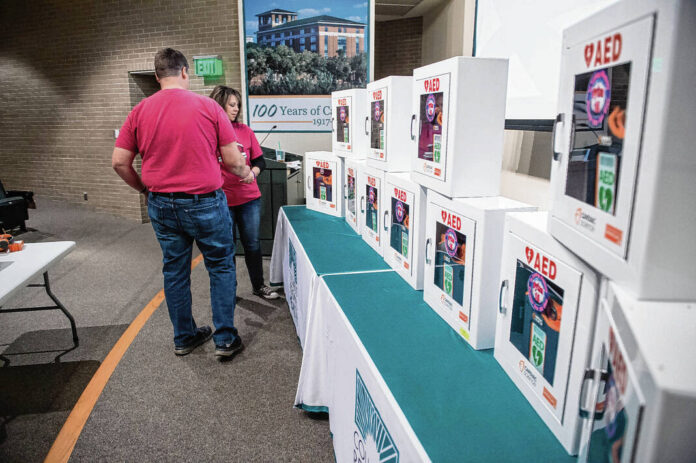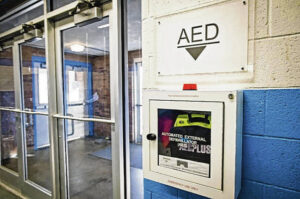Bill would require schools to have AEDs at all sporting events

Erick and Georgiana Williams review 10 Automated External Defibrillators, or AEDs, to be donated to various athletic facilities across the county at Columbus Regional Hospital in February 2017.
File photo of the Republic
24 years ago last week, Lawrence North basketball star John Stewart collapsed and died during a regional basketball game against Bloomington South in Columbus North.
Like most high schools across Indiana at the time, North did not have automated external defibrillators or AEDs at the time. EMTs tried to revive the 7-foot, 275-pound Stewart for about 25 minutes before he was rushed to Columbus Regional Hospital, where he was pronounced dead as a victim of idiopathic hypertrophic cardiomyopathy.
Soon after, lawmakers began ensuring that all schools were equipped with AEDs. Now they are going one step further and are looking for AEDs to be present at all indoor and outdoor sporting events.
Senate Bill 369, co-authored by Senator Greg Walker, R-Columbus, would require school coaches, marching band leaders and extracurricular activity leaders to ensure that an operational AED is available at all sporting events. The bill would require the devices to be accessible within three minutes, except off-road.
The bill would also require schools to maintain the devices and develop and communicate site-specific emergency plans in the event of cardiac arrest.
The bill sailed through the Indiana Senate last month by a 49-0 vote and is pending in the Indiana House.
Defibrillators “have changed a lot in the last five or six years, maybe 10 years,” said Steve Souder, who was an athletic trainer at Columbus North for 43 years and at Hauser for the past two years. “John Stewart, when he died, they didn’t exist. The only ones they had were paramedics or EMTs.”
 The death of Lawrence North basketball star John Stewart during a regional game in Columbus North in 1999 prompted schools across the state to procure defibrillators to place in or near their gyms, like this one in Columbus North pictured Tuesday , March 11, 2014.
The death of Lawrence North basketball star John Stewart during a regional game in Columbus North in 1999 prompted schools across the state to procure defibrillators to place in or near their gyms, like this one in Columbus North pictured Tuesday , March 11, 2014.
File photo of the Republic
Bartholomew County schools have had AEDs for several years, each costing about $1,800. North has them at the main gym, pool area, and baseball and softball complex, and a portable device that can be taken to the soccer field.
Columbus East has AEDs located just outside of its main and secondary gymnasiums, pool area, and in front of the main office, as well as a portable AED that can be taken to the football, baseball, and softball fields. Coaches from both schools also take a portable AED to games at the BCSC Soccer Complex.
“Coaches always carry portable equipment with them,” said Pete Huse, East’s athletics director. “There are state laws about where to position them and I know we comply with the code. We placed them where they would meet the code for all of our sporting events.”
Hauser has AEDs in its main gym, field house, training room, main office and elementary school. Souder said the school is working on getting one for the softball field as well, and he’s taken wearables to softball and baseball games.
“We have some in the building,” Souder said. “It was the same with North. If I know there won’t be a trainer at the event (on the street) I’ll bring one, but that’s very rarely anymore.”
But Souder mentioned that demand for AEDs will likely be greater than current supply when the law goes into effect, and there may be a six-month to a year wait before some schools receive them.
All certified staff and trainers must be trained in the use of AEDs to keep their license active. Also, all coaches are required to complete a sudden cardiac arrest course through the National Federation of High Schools (NFHS).
“The new guys take you through everything,” said Brian Lewis, North’s athletics director. “Anyone off the street can do that. If another adult sees someone struggling, then of course (they can use it).”
Huss agreed.
“Once you start the process, you are guided through it,” Huse said. “So the person is quiet and listens. If you attach the pads incorrectly, it will tell you. It will let you know when it’s ready to deliver a load. The way an AED works, anyone can use it to save someone’s life if they follow the instructions.”